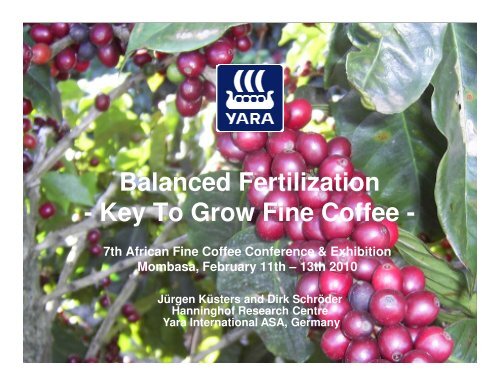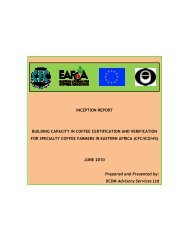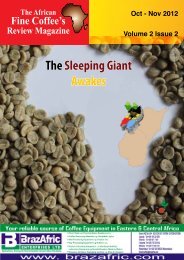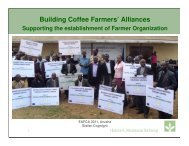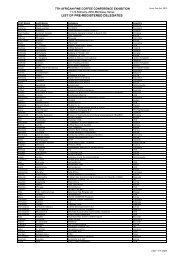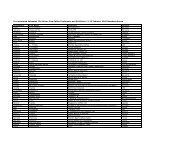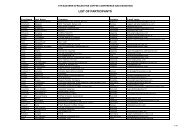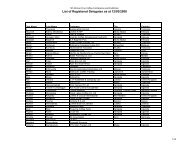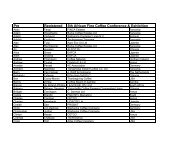Balanced Fertilization - Key To Grow Fine Coffee - - EAFCA
Balanced Fertilization - Key To Grow Fine Coffee - - EAFCA
Balanced Fertilization - Key To Grow Fine Coffee - - EAFCA
You also want an ePaper? Increase the reach of your titles
YUMPU automatically turns print PDFs into web optimized ePapers that Google loves.
<strong>Balanced</strong> <strong>Fertilization</strong><br />
- <strong>Key</strong> <strong>To</strong> <strong>Grow</strong> <strong>Fine</strong> <strong>Coffee</strong> -<br />
7th African <strong>Fine</strong> <strong>Coffee</strong> Conference & Exhibition<br />
Mombasa, February 11th – 13th 2010<br />
Jürgen Küsters and Dirk Schröder<br />
Hanninghof Research Centre<br />
Yara International ASA, Germany
How to approach a balanced fertilizer<br />
strategy for coffee<br />
1. Know your crop => yield expectation, quality requirements<br />
2. Know your soil => pH, nutrient contents, CEC etc. => soil analysis<br />
3. Optimize growth factors (pH, water, plant protection)<br />
4. Develop a fertilizer strategy<br />
– Which nutrients should be applied and in which form?<br />
– How much nutrients at which time?<br />
5. Monitor the effect of fertilization through soil and leaf analysis<br />
Date: 2010-02-13 Jürgen Küsters © Yara International ASA
Crop knowledge is important:<br />
The effect of nutrients on yield and quality<br />
REF: Yara (Literature Review)<br />
Date: 2010-02-13 Jürgen Küsters © Yara International ASA
Liebig’s barrel illustrates the<br />
Law of the Minimum<br />
Crop yield is limited by the one essential mineral<br />
nutrient that is in the relatively shortest supply.<br />
Jahr => 1985 2005 Veränderung<br />
Ertrag => 58 dt/ha 80 dt/ha + 22 dt/ha<br />
Nährstoffentzüge Korn + Stroh, kg/ha<br />
N 139 192 + 53<br />
P 27 38 + 11<br />
K 87 120 + 33<br />
B<br />
Zn<br />
Mg 13 18 + 5<br />
S 17 24 + 7<br />
Date: 2010-02-13 Jürgen Küsters © Yara International ASA
Lack of one macronutrient reduces yield<br />
of the coffee crop<br />
- Arabica<br />
Yield (kg/ha)<br />
100 %<br />
-15%<br />
-27%<br />
-37%<br />
-93%<br />
REF: <strong>Coffee</strong> manual - Brazil<br />
Date: 2010-02-13 Jürgen Küsters © Yara International ASA
Sulfur in soils and Yield<br />
- Arabica<br />
Yield (kg/ha)<br />
4000<br />
3500<br />
3000<br />
2500<br />
2000<br />
1500<br />
1000<br />
0 5 10 15 20<br />
Soil S (ppm)<br />
Studies suggest that 10 to 15 ppm SO4-S is adequate.<br />
REF: Malavolta et al. – Brazil, 1987<br />
Date: 2010-02-13 Jürgen Küsters © Yara International ASA
Potassium and Processed <strong>Coffee</strong> Quality<br />
- Arabica<br />
Polyphenoloxidase activity (U/g)<br />
68<br />
66<br />
64<br />
Very soft quality<br />
Soft quality<br />
62<br />
60<br />
58<br />
56<br />
54<br />
Hard quality<br />
Very hard – acid - poor<br />
0 120 240 480<br />
K fertilizer rate (kg K2O/ha)<br />
REF: de Barros Silva et al. – Brazil, 2002<br />
Date: 2010-02-13 Jürgen Küsters © Yara International ASA
Boron spray and Bean Size<br />
- Robusta<br />
% beans on sieves<br />
Ref: Agriculture and Forestry Scientific Research Institute – Vietnam, 1997<br />
Date: 2010-02-13 Jürgen Küsters © Yara International ASA
Zinc spray - Yield and Bean Weight<br />
- Arabica<br />
%<br />
118<br />
115<br />
112<br />
109<br />
106<br />
103<br />
Leaf Zn (ppm):<br />
Control: 5.6<br />
Spray: 14.5<br />
Optimum leaf standard:<br />
12-30 ppm<br />
100<br />
Control = 100 %<br />
Bean yield<br />
Bean weight<br />
Marketable<br />
yield<br />
REF: Lambot – Burundi, 1989<br />
Date: 2010-02-13 Jürgen Küsters © Yara International ASA
How to approach a balanced fertilizer<br />
strategy for coffee<br />
1. Know your crop => yield expectation, quality requirements<br />
2. Know your soil => pH, nutrient contents, CEC etc. => soil analysis<br />
3. Optimize growth factors (pH, water, plant protection)<br />
4. Develop a fertilizer strategy<br />
– Which nutrients should be applied and in which form?<br />
– How much nutrients at which time?<br />
5. Monitor the effect of fertilization through soil and leaf analysis<br />
Date: 2010-02-13 Jürgen Küsters © Yara International ASA
Nutrient removal by the crop at harvest<br />
- Arabica<br />
Macronutrients (kg/1000 kg green bean)<br />
70<br />
60<br />
50<br />
40<br />
30<br />
20<br />
10<br />
Micronutrients (g/1000 kg green bean)<br />
120<br />
100<br />
80<br />
60<br />
40<br />
20<br />
0<br />
N P2O5 K20 CaO MgO S<br />
0<br />
B Cu Fe Mn Zn<br />
Green bean<br />
Whole berry (equivalent to 1000 kg green bean)<br />
REF: Malavolta – Brazil, 1990<br />
Date: 2010-02-13 Jürgen Küsters © Yara International ASA
Soil pH and nutrient availability<br />
pH of East<br />
African<br />
soils<br />
Optimum<br />
for coffee<br />
Date: 2010-02-13 Jürgen Küsters © Yara International ASA
Nutrient requirements of coffee<br />
in Eastern Africa (generalized)<br />
N, P, Ca, S:<br />
<br />
K:<br />
<br />
<br />
Required, because of low availability in soils and/or high removal<br />
– History of low inputs (N, S)<br />
– P fixation at low pH => efficient (highly soluble) P form or P leaf spray<br />
– Low CEC (Ca), leaching (Ca, N)<br />
Application according to K removal with harvest (soils relatively high in K)<br />
However, if yield expectations and/or quality requirements are high, K may<br />
be required at higher rates<br />
B, Zn:<br />
<br />
<br />
Required, because of low soil content or low efficiency in soil<br />
Zn leaf spray more efficient than Zn soil application<br />
Mg, Fe, Mn, Cu:<br />
<br />
Not required or only in low amounts (high soil content, low removal,<br />
Cu: fungicide spray)<br />
Date: 2010-02-13 Jürgen Küsters © Yara International ASA
Example for a balanced fertilizer strategy<br />
to a coffee crop in Eastern Africa<br />
<strong>Key</strong> nutrients<br />
N, P, Mg, Ca, S, B, Zn<br />
N, P, K, Ca<br />
N, P, B, Zn<br />
NPK<br />
(each application<br />
@ 150-250 kg/ha)<br />
Calcium nitrate + B<br />
(soil application @<br />
200-300 kg/ha)<br />
20-10-10<br />
or<br />
22-6-12<br />
+Mg+S+B<br />
N, Ca, B<br />
AND/OR<br />
20-10-10<br />
or<br />
22-6-12<br />
+Mg+S+B<br />
20-10-10<br />
or<br />
22-6-12<br />
+Mg+S+B<br />
Foliar spray<br />
P, Mg, S<br />
B, Zn<br />
P, K<br />
B, Zn<br />
Date: 2010-02-13 Jürgen Küsters © Yara International ASA
Thank You !<br />
juergen.kuesters@yara.com<br />
Date: 2010-02-13 Jürgen Küsters © Yara International ASA


